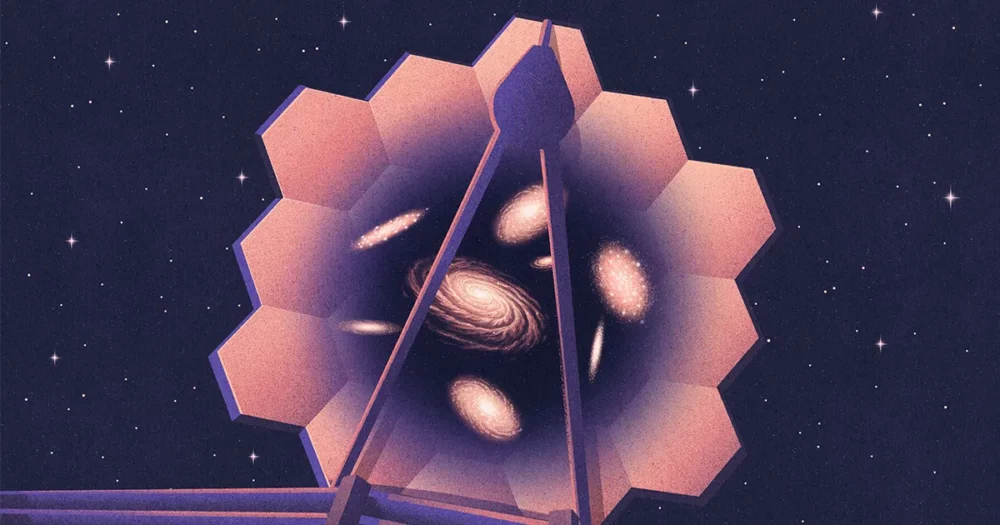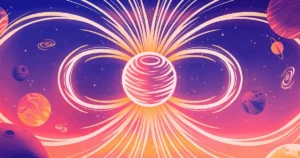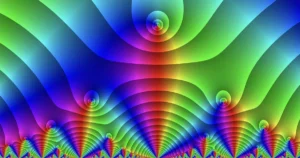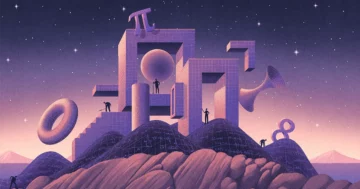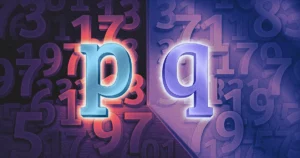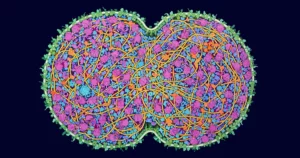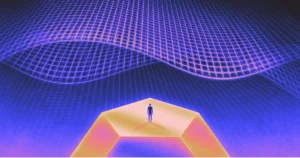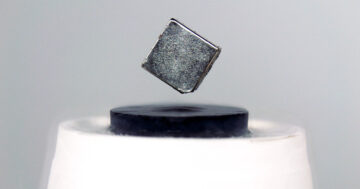
Introduction
The year began right as the James Webb Space Telescope was unfurling its sunshield — the giant, nail-bitingly thin and delicate blanket that, once open, would plunge the observatory into frigid shade and open up its view of the infrared universe. Within hours of the ball dropping here in New York City, the sunshield could have caught on a snag, ruining the new telescope and tossing billions of dollars and decades of work into the void. Instead, the sunshield opened perfectly, getting the new year in physics off to an excellent start.
JWST soon started to glimpse gorgeous new faces of the cosmos. On July 11, President Biden unveiled the telescope’s first public image — a panoramic view of thousands of galaxies various distances away in space and time. Four more instantly iconic images were released the next day. Since then, the telescope’s data has been distributed among hundreds of astronomers and cosmologists, and cosmic discoveries and papers are pouring forth.
Astronomy is swimming in fresh data of all kinds. In May, for instance, the Event Horizon Telescope released the first-ever photo of the supermassive black hole in the heart of our galaxy — one of several recent observations that are helping astrophysicists figure out how galaxies operate. Other telescopes are mapping the locations of millions of galaxies, an effort that recently yielded surprising evidence of an asymmetry in galaxy distribution.
Breakthroughs are coming fast in condensed matter physics, too. An experiment published in September all but proved the origin of high-temperature superconductivity, which could help in the field’s perennial quest for an even warmer version of the phenomenon that could work at room temperature. That’s also a goal of research on two-dimensional materials. This year, a kind of flat crystal that once helped lubricate skis has emerged as a powerful platform for exotic, potentially useful quantum phenomena.
Particle physicists, who seek new fundamental ingredients of the universe, have been less lucky. They’ve continued to unravel features of particles we already know of — including the proton, the subject of a wonderful visual project we published this fall. But theorists have few if any concrete clues about how to go beyond the Standard Model of particle physics, the stiflingly comprehensive set of equations for the quantum world that’s been the theory to beat for half a century. Hope is a virtue, though, and at least one possible crack in the Standard Model did open up this year. Let’s start the 2022 greatest-hits list there.
Introduction
The Tevatron collider in Illinois smashed its last protons a decade ago, but its handlers have continued to analyze its detections of W bosons — particles that mediate the weak force. They announced in April that, by painstakingly tracking down and eliminating sources of error in the data, they’d measured the mass of the W boson more precisely than ever before and found the particle significantly heavier than predicted by the Standard Model of particle physics.
A true discrepancy with the Standard Model would be a monumental discovery, pointing to new particles or effects beyond the theory’s purview. But hold the applause. Other experiments weighing the W — most notably the ATLAS experiment at Europe’s Large Hadron Collider — measured a mass much closer to the Standard Model prediction. The new Tevatron measurement purports to be more precise, but one or both groups might have missed some subtle source of error.
The ATLAS experiment aims to resolve the matter. As Guillaume Unal, a member of ATLAS, said, “The W boson has to be the same on both sides of the Atlantic.”
Introduction
All that buzz about a tenuous hint of a problem with the Standard Model reflects the troubled situation particle physicists find themselves in. The 17 elementary particles known to exist — the ones described by the Standard Model — don’t solve all the mysteries of the universe. Yet the Large Hadron Collider hasn’t turned up an 18th.
For years, theorists have struggled with how to proceed. But recently, a new direction has opened up. Theorists are rethinking a long-held assumption known as naturalness — a way of reasoning about what’s natural or expected in the laws of nature. The idea is closely connected to nature’s reductionist, nesting-doll structure, where big stuff is explained by smaller stuff. Now theorists wonder if profound naturalness problems like the lack of new particles from the Large Hadron Collider might mean the laws of nature aren’t structured in such a simple bottom-up way after all. In a spate of new papers, they’re exploring how gravity might dramatically change the picture.
“Some people call it a crisis,” said the theoretical particle physicist Isabel Garcia Garcia, referring to the current moment in the field. But that’s too pessimistic, in her view: “It’s a time where I feel like we are on to something profound.”
(Incidentally, as well as rethinking naturalness, Garcia Garcia also studies the physics of nothing — the subject of a rollicking explainer published in August.)
Introduction
Thousands of condensed matter physicists have studied graphene, a crystal sheet made of carbon atoms that has special properties. But lately a new family of flat crystals has hit the scene: transition metal dichalcogenides, or TMDs. Stacking different TMDs gives rise to bespoke materials with different quantum properties and behaviors.
The near-magical properties of these materials are known largely thanks to Jie Shan and Kin Fai Mak, a married couple who co-run a lab at Cornell University. Quanta’s profile of Shan and Mak, published this past summer, tells the story of 2D materials against the backdrop of condensed matter physics, while also unpacking a slew of exciting new breakthroughs spilling out of Shan and Mak’s lab, from artificial atoms to long-lived excitons. A short documentary about the duo and their discoveries also appeared on Quanta’s YouTube channel.
Introduction
In November, physicists announced a first-of-its-kind “quantum gravity experiment on a chip,” in the words of team leader Maria Spiropulu of the California Institute of Technology. They ran a “wormhole teleportation protocol” on Google’s Sycamore quantum computer, manipulating the flow of quantum information in the computer in such a way that it was mathematically equivalent, or dual, to information passing through a wormhole between two points in space-time.
To be clear, the wormhole isn’t part of the space-time we inhabit. It’s a sort of simulation or hologram — though not one of the kinds we’re used to — and it has a different space-time geometry than the real, positively curved, 4D space-time we live in. The point of the experiment was to demonstrate holographic duality, a major theoretical discovery of the last 25 years which states that certain quantum systems of particles can be interpreted as a bendy, gravitating space-time continuum. (The space-time can loosely be thought of as a hologram that emerges from the lower-dimensional quantum system.) In more advanced quantum computer experiments in the coming years, researchers hope to explore the mechanics of holographic duality, with the ultimate goal of unraveling whether “gravity in our universe is emergent from some quantum [bits] in the same way that this little baby one-dimensional wormhole is emergent” from the Sycamore chip, said Daniel Jafferis of Harvard University, who developed the wormhole teleportation protocol.
The holographic wormhole spawned endless opinions among physicists and lay readers alike. Some physicists thought the quantum simulation was too pared down compared to the theoretical model it was based on to have a holographic dual description as a wormhole. Many felt that the physicists behind the work, and we, the journalists who covered it, should have better emphasized that this was not an actual wormhole that could transport people to Andromeda. Indeed, to open up a wormhole in real space-time, you’d need negative-energy material, and that doesn’t seem to exist.
Introduction
The biggest thing in physics this year is floating a million miles away, at a spot in space called Lagrange Point 2, where its sunshield can simultaneously block out the Earth, moon and sun. JWST’s images have made hearts stand still. Its data is already reshaping our understanding of the cosmos.
When Biden unveiled JWST’s first image, researchers immediately began spotting interesting galaxies in the vast tableau. Scientific papers appeared online within days. Two weeks later, Quanta reported that JWST data had already yielded new discoveries about galaxies, stars, exoplanets and even Jupiter. One of the most exciting early findings was that galaxies seem to have assembled surprisingly early in cosmic history — perhaps even earlier than cosmological models can easily explain. Expect to hear more about this in 2023.
We’ll also have to wait patiently for JWST’s much-anticipated studies of the rocky planets in a nearby star system called TRAPPIST-1. A key JWST specialty is to dissect the starlight that pierces the atmosphere of a distant planet as the planet moves across the face of its star. This reveals what the planet’s atmosphere is made of, including possible evidence of “biosignature” gases that might signify alien biology. The telescope has produced excellent exoplanet spectra already. But potentially habitable worlds, like the TRAPPIST-1 planets, are so small that they’ll need to transit in front of their suns a few times over the next few years before atmospheric features will show up.
Seeing clear-cut biosignatures in their skies might be unlikely. Still, some astronomers have waited their whole careers for the search to begin. Lisa Kaltenegger, director of the Carl Sagan Institute at Cornell University and one of the leading computer modelers of potentially habitable worlds, came of age just as the first exoplanets were discovered. She joined a cadre of dreamers who started thinking about how to find life on one. Our profile of Kaltenegger describes how she and her generation of exoplanet astronomers have planned for this era for decades, setting the stage for an epochal detection. More on that in the coming years.
- SEO Powered Content & PR Distribution. Get Amplified Today.
- Platoblockchain. Web3 Metaverse Intelligence. Knowledge Amplified. Access Here.
- Source: https://www.quantamagazine.org/the-biggest-discoveries-in-physics-in-2022-20221222/
- 11
- 2022
- 2D
- 2D materials
- a
- About
- across
- advanced
- After
- against
- aims
- alien
- All
- already
- among
- analyze
- and
- announced
- appeared
- April
- artificial
- assembled
- assumption
- Atmosphere
- atmospheric
- AUGUST
- Baby
- backdrop
- based
- before
- began
- behind
- Better
- between
- Beyond
- biden
- Big
- Biggest
- billions
- biology
- Black
- Block
- Both Sides
- breakthroughs
- california
- call
- called
- carbon
- careers
- caught
- Century
- certain
- change
- chip
- City
- clear
- closely
- closer
- coming
- compared
- comprehensive
- computer
- Condensed matter
- connected
- continued
- Continuum
- Cosmos
- could
- Couple
- covered
- crack
- crisis
- Crystal
- Current
- Daniel
- data
- day
- Days
- decade
- decades
- demonstrate
- described
- description
- Detection
- developed
- DID
- different
- direction
- Director
- discovered
- discovery
- discrepancy
- distributed
- Doesn’t
- dollars
- Dont
- down
- dramatically
- Dropping
- Earlier
- Early
- earth
- easily
- effects
- effort
- eliminating
- emerged
- emerges
- emphasized
- Endless
- equations
- Equivalent
- Era
- error
- Europes
- Even
- Event
- Event Horizon Telescope
- EVER
- evidence
- excellent
- exciting
- Exoplanet
- Exotic
- expect
- expected
- experiment
- Explain
- explained
- explore
- Exploring
- Face
- faces
- FAI
- Fall
- family
- FAST
- Features
- few
- field
- Find
- First
- flat
- floating
- flow
- Force
- fresh
- from
- front
- fundamental
- Galaxies
- Galaxy
- generation
- getting
- giant
- gives
- Glimpse
- Go
- goal
- Google’s
- Graphene
- gravity
- Group’s
- Half
- harvard
- harvard university
- Heart
- help
- helped
- helping
- here
- history
- Hit
- hold
- Hologram
- holographic
- hope
- horizon
- HOURS
- How
- How To
- HTTPS
- Hundreds
- iconic
- idea
- illinois
- image
- images
- immediately
- in
- Including
- information
- instance
- instead
- Institute
- interesting
- IT
- James Webb Space Telescope
- joined
- Journalists
- July
- Jupiter
- Key
- Kin
- Kind
- Know
- known
- lab
- Lack
- large
- largely
- Last
- Laws
- leader
- leading
- Life
- List
- little
- live
- locations
- made
- major
- manipulating
- many
- mapping
- Mass
- material
- materials
- mathematically
- Matter
- mechanics
- member
- metal
- might
- million
- millions
- model
- models
- moment
- monumental
- Moon
- more
- most
- moves
- much-anticipated
- Natural
- Nature
- Need
- New
- new year
- New York
- new york city
- next
- notably
- November
- observatory
- ONE
- online
- open
- opened
- Opinions
- Other
- papers
- part
- Passing
- past
- patiently
- People
- perhaps
- pessimistic
- phenomenon
- Physics
- picture
- planet
- Planets
- planned
- platform
- plato
- Plato Data Intelligence
- PlatoData
- plunge
- Point
- points
- possible
- potentially
- powerful
- precisely
- prediction
- president
- president biden
- Problem
- problems
- Produced
- project
- properties
- protocol
- protons
- proved
- public
- published
- Quantamagazine
- Quantum
- Quantum Computer
- quantum information
- quantum systems
- quest
- readers
- real
- recent
- recently
- reflects
- released
- research
- researchers
- Reveals
- Rise
- rocky
- Room
- Said
- same
- scene
- Search
- Seek
- September
- set
- setting
- several
- Short
- should
- show
- Sides
- Simple
- simulation
- simultaneously
- since
- situation
- skies
- small
- smaller
- So
- SOLVE
- some
- something
- Source
- Sources
- Space
- Space and Time
- special
- Specialty
- Spot
- stacking
- Stage
- stand
- standard
- Star
- Stars
- start
- started
- States
- Still
- Story
- structure
- structured
- studied
- studies
- subject
- such
- summer
- Sun
- surprising
- system
- Systems
- Tableau
- team
- Technology
- telescopes
- tells
- The
- their
- themselves
- theoretical
- thing
- Thinking
- this year
- thought
- thousands
- Through
- time
- times
- to
- too
- Tracking
- transit
- transition
- transport
- true
- Turned
- ultimate
- understanding
- Universe
- university
- Unpacking
- unveiled
- various
- Vast
- version
- View
- W
- wait
- webp
- Weeks
- weighing
- What
- whether
- which
- while
- WHO
- will
- within
- wonderful
- words
- Work
- world
- world’s
- wormhole
- would
- year
- years
- youtube
- zephyrnet

